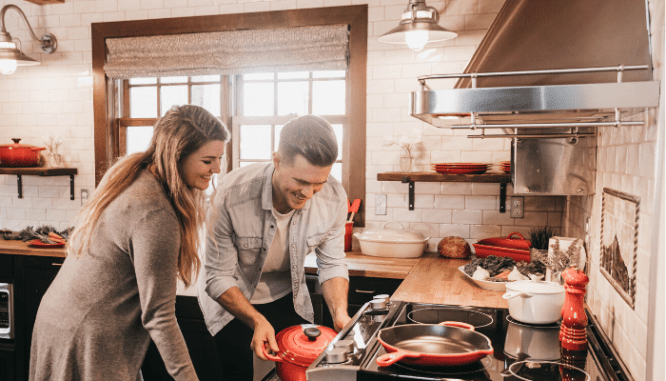Does Remodeling Increase Home Value or Offer Disappointing Returns?
- Published on
- 4 min read
-
 HomeLightClose
HomeLightClose HomeLight
HomeLightHomeLight’s vision is a world where every real estate transaction is simple, certain, and satisfying. We build software and provide services to home buyers, sellers, and real estate agents.
It’s the question on the tip of every homeowner’s tongue. Does remodeling increase home value? Top-selling Phoenix, AZ, real estate agent Bill Watson puts it simply.
“If you spent $50,000 to completely change rooms, you’re going to get $25,000 to $35,000 back.”
But there are a lot of variables that factor into this equation, including which rooms you choose to overhaul, your material selection, and whether you opt for styles that will be marketable in the future. What you’ll get back also depends on your experience level: investors will have a better shot at turning a nice profit (by purchasing a home at a bargain) versus an owner who’s picking out new bathroom tile for the first time and paid market value.
Here we’ll dig into the latest trends around American home remodeling and what some of the most popular projects have to offer — including the hard ROI data on kitchens, baths, and layout changes, and best practices for squeezing the most out of any investment you take on.
What types of projects fall into the ‘remodeling’ camp?
Remodeling is a term used loosely in real estate to describe all sorts of home improvement projects, but if you want to get technical, a true “remodel” (versus an update, refresh, or renovation) is defined as any project that alters the structure or form of a property or in other words…”remakes it.”
When you do major demolition, rip up worn floors, tear down walls that close off spaces, reconfigure entire layouts, or replace major elements of the home, you’re in remodeling territory. (Think of the types of dramatic room makeovers you see on TV where there’s lots of dust and chaos).
Projects like applying fresh paint or swapping out hardware don’t really count as “remodeling.” And in the same vein, if you call in a repair pro to fix the garbage disposal, that’s not remodeling, either. It’s just basic maintenance.
Spending on American home remodeling is trending upward
Americans spend more than $400 billion a year on improving their house. In fact, remodeling reached a new high of $424 billion in 2017, growing over 50% since 2010, according to the Joint Center for Housing Studies 2019 “Improving America’s Housing” report.
And while houses are built to be sturdy and last for centuries, that doesn’t mean they don’t age. There’s a reason why homeowners bite the bullet and gut rooms that need work. Eventually you’ll reduce your own living enjoyment and your ability to market the property to future buyers if you fail to do any updates. Plus, many properties aren’t the young spry chickens they used to be. The median age of owner-occupied homes in the U.S. is 37 years old, while 40% of the nation’s 137 million homes are at least 50.
You can make small updates here and there — or liven up a room with a simple coat of paint — to keep your house looking fresh. However, when the tiles eventually start to detach from the floor or your main rooms start to feel entirely dated, the writing’s on the wall: it’s time to think about some serious remodeling.
Any smart homeowner wants to take on a remodel carefully and with an eye on the ROI — data from Home Advisor shows that most home remodels cost between $18,000 and $76,000, and certain remodeling projects can get out of hand… fast.

When in doubt, start with the kitchen
Watson, who’s represented real estate clients for 23 years, always suggests tackling the kitchen first. As the heart of the home where family and friends gather, the kitchen is often the most used room in the house. While a roomy kitchen will sell, great appliances and a nice countertop flow make cooking dinner a joy. What a dream compared to cramped layouts and a stove that takes ages to heat up!
What the data says on kitchen remodels:
No doubt about it: a well-remodeled kitchen has the potential to “wow” buyers and help you maximize your home’s value… but you won’t get back every penny you spend. According to data from Remodeling Magazine’s 2020 Cost versus Value report, kitchen remodels have an ROI ranging from 54%-78% depending on the scope of the project and how upscale you want to go.
Tips to maximize the value from your kitchen remodel:
- Go for the walk-in pantry.
A walk-in pantry to store condiments, canned goods, and bulky cereal boxes was the most-wanted kitchen feature among recent and prospective homebuyers polled in the National Association of Home Builders (NAHB) 2019 “What Home Buyers Really Want” report.
- Stick with classic stainless steel.
75% of top real estate agents across the country say traditional stainless steel remains the most in-demand appliance finish among homebuyers today, according to HomeLight’s Top Agent Insights Survey for Q3 2019.
- Leave cabinet boxes in place, and just replace the fronts.
Updating cabinets with shaker-style wood panels and drawer fronts as part of a minor kitchen remodel can help you recoup nearly 80% of your spend, data from Remodeling Magazine shows.
Tackle the bathrooms next
An old or deteriorating bathroom is an eyesore at best and a nightmare for daily hygiene at worst. A sparkling, modern bathroom that evokes cleanliness and relaxation can be a huge selling point for your home. Chances are if you’re tired of dealing with a beat-up tub and dated fixtures, a bathroom remodel will be high on your priority list.
What the data says on bathroom remodels:
As is the case with the kitchen, bathroom remodels won’t necessarily recoup everything you spent once you resell. If you spend $35,000 remodeling a bathroom, you’ll recover an estimated $20,000 of that cost for a 57% ROI, data from the National Association of Realtors 2019 Remodeling Impact Report shows.
Tips to maximize the value from your bathroom remodel:
- Add a built-in linen closet.
The NAHB survey showed that 78% of homebuyers say a master-bathroom linen closet is either a desirable or must-have bathroom feature, outranking a shower stall and tub or double vanity on homebuyers’ wish lists. - Make the bathroom bigger.
The American Institute of Architects Home Design Trends Survey shows that more home designers are reporting that bathroom size is increasing in American homes. - Ditch the jacuzzi in favor of a spa-retreat shower.
Whirlpool tubs are out, and showers are in. In fact, according to the AIA survey, residential architects say doorless showers (56%), stall showers without tubs (54%), large walk-in showers (63%), and upscale showers (23%) are all increasing in popularity. - Want to add a new bath? Put it on the lower level.
Add a bathroom to a basement to save you anywhere from 25% to 50%, compared to the cost of adding a room to the first or second floor.

Change the layout
One study showed that homes with open floor plans appreciate at a rate of 7.4% faster than their closed-off counterparts. But there’s also talk about the death of the open concept. Whether you think your home has too many walls or you crave a little more privacy, follow these tips to make sure any layout change project goes smoothly and that you’ve thought through all of your options.
Get a professional opinion before you tear down walls.
Before you take to a sledgehammer to your heart’s content, get a structural engineer or remodeling contractor to weigh in and answer the following questions:
- Does the wall shoulder structural weight? If so, do you need a header beam?
- Are there electrical wires, ducts, or plumbing parts in the wall?
- Can lead paint be lurking? (If your home’s circa 1978 or earlier, this known health hazard can be an issue.)
Tearing out studs can cost $4 to $6 per square foot, but if you need to replace wiring, ducts, plumbing, or other mechanical elements on a load-bearing wall, it could cost $10,000 or more.
Don’t be the McMansion of the neighborhood.
If you live in a neighborhood where most of the homes are 1,800 square feet, believe or not, the 3,500 square footers are going to stick out like a sore thumb. The point is, adding too much square footage could make your house harder to sell down the line as buyers in the area won’t be looking to take on quite so much house.
Steal space from one unused room to make another one bigger.
Get creative with your room switcheroo: Borrow square footage for one room that you don’t use very much to make another one more enjoyable or functional. Let’s say you donate rarely-touched dining room space for the sake of a chef’s kitchen or a spacious living room. However, in the reshuffle you want to avoid losing valuable storage, so preserve those shelves, closets, and cabinets if you can.
Remodeling your home: Maximize your enjoyment, and think of your returns as a bonus.
Many homeowners go into a remodeling project with high hopes for recouping exactly what they paid and then some. But the data shows it doesn’t usually play out that way. If you’re smart about your decisions, and keep resale potential in mind, you’re sure to get some of that money back… but not all of it.
So ask yourself how much value you’ll get from your expenditure and your lifestyle improvement from the remodel. Think of things like parties and family get-togethers to the day-to-day. If whatever joy you’ll get out of the change seems worth it, then any returns you get at resale will feel like a great bonus.
Header Image Source: (Sharon McCutcheon / Unsplash)
